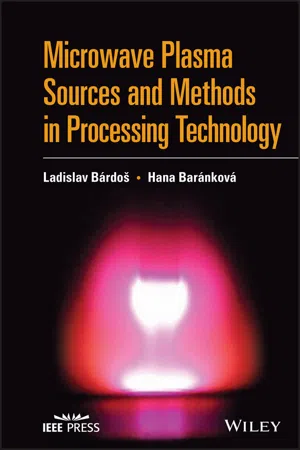
Microwave Plasma Sources and Methods in Processing Technology
Ladislav Bardos,Hana Barankova
- English
- ePUB (mobile friendly)
- Available on iOS & Android
Microwave Plasma Sources and Methods in Processing Technology
Ladislav Bardos,Hana Barankova
About This Book
A practical introduction to microwave plasma for processing applications at a variety of pressures
In Microwave Plasma Sources and Methods in Processing Technology, the authors deliver a comprehensive introduction to microwaves and microwave-generated plasmas. Ideal for anyone interested in non-thermal gas discharge plasmas and their applications, the book includes detailed descriptions, explanations, and practical guidance for the study and use of microwave power, microwave components, plasma, and plasma generation.
This reference includes over 130 full-color diagrams to illustrate the concepts discussed within. The distinguished authors discuss the plasmas generated at different levels of power, as well as their applications at reduced, atmospheric and higher pressures. They also describe plasmas inside liquids and plasma interactions with combustion flames.
Microwave Plasma Sources and Methods in Processing Technology concludes with an incisive exploration of new trends in the study and application of microwave discharges, offering promising new areas of study.
The book also includes:
• A thorough introduction to the basic principles of microwave techniques and power systems, including a history of the technology, microwave generators, waveguides, and wave propagation
• A comprehensive exploration of the fundamentals of the physics of gas discharge plasmas, including plasma generation, Townsend coefficients, and the Paschen curve
• Practical discussions of the interaction between plasmas and solid surfaces and gases, including PVD, PE CVD, oxidation, sputtering, evaporation, dry etching, surface activation, and cleaning
• In-depth examinations of microwave plasma systems for plasma processing at varied parameters
Perfect for researchers and engineers in the microwave community, as well as those who work with plasma applications, Microwave Plasma Sources and Methods in Processing Technology will also earn a place in the libraries of graduate and PhD students studying engineering physics, microwave engineering, and plasmas.
Frequently asked questions
Information
1
Basic Principles and Components in the Microwave Techniques and Power Systems
1.1 History in Brief – From Alternating Current to Electromagnetic Waves and to Microwaves

| λ ≈ 1–100 pm (picometer) |
| λ ≈ 100 pm–100 nm |
| λ ≈ 100–300 nm |
| λ ≈ 350–750 nm |
| λ ≈ 750 nm–1 mm |
| λ ≈ 1 mm–1 m |
| λ ≈ 1 m–100 km |
| f ≈ 3 × (1020–1018) Hz |
| f ≈ 3 × (1018–1015) Hz |
| f ≈ 3 × 1015–1015 Hz |
| f ≈ 9 × 1014–4 × 1014 Hz |
| f ≈ 4 × 1014–3 × 1011 Hz |
| f ≈ 3 × 101–3 × 108 Hz |
| f ≈ 3 × 108–3 × 104 Hz |
| 103 Hz (Kilohertz) |
| 106 Hz (Megahertz) |
| 109 Hz (Gigahertz) |
| 1012 Hz (Terahertz) |
| 1015 Hz (Petahertz) |
| 1018 Hz (Exahertz) |
| 1021 Hz (Zettahertz) |
| 1024 Hz (Yottahertz). |
Table of contents
- Cover
- Title page
- Copyright
- Table of Contents
- Foreword from the Authors
- 1 Basic Principles and Components in the Microwave Techniques and Power Systems
- 2 Gas Discharge Plasmas
- 3 Interactions of Plasmas with Solids and Gases
- 4 Microwave Plasma Systems for Plasma Processing at Reduced Pressures
- 5 Microwave Plasma Systems at Atmospheric and Higher Pressures
- 6 New Applications and Trends in the Microwave Plasmas
- 7 Appendices
- Index
- End User License Agreement